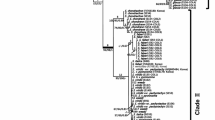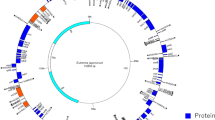Abstract
Seeds from species of Canarium L. (Burseraceae) have been recommended as a potential nut crop for global trade that, if adopted, would be the first ‘new’ nut commodity since the introduction of the Macadamia nut in the early 20th century. The present study addresses several knowledge gaps about the evolutionary biology of Canarium species in order to explore their phylogeny and cultivation history in greater detail. The phylogeny of select Canarium species (16 spp.) from the three taxonomic sections of the genus was reconstructed using DNA sequence data from seven regions and included cultivated species C. album (Lour.) Raeusch., C. decumanum Gaertn., C. harveyi Seem., C. indicum L., C. ovatum Engl., C. tramdenum C.D. Dai et Yakovlev, and C. vulgare Leenh.. Sequence data from the nuclear genome (rDNA external transcribed spacer (ETS), the third intron of nitrate reductase (NIA-i3)) and the chloroplast genome (rbcL, rps16 intron, psbA-trnH spacer, trnL intron and trnL-F spacer) were analyzed using parsimony and Bayesian inference. Results indicate that Canarium comprises at least two distantly related evolutionary lineages within its tribe, desirable fruit characteristics of cultivated and wild-harvested edible species have evolved multiple times, and autopolyploidization rather than allopolyploidization may have been associated with speciation in Canarium sensu stricto. The markers ETS, NIA-i3, rps16 intron, and psbA-trnH spacer will provide the most informative variation for future expanded studies of Canarium phylogeny, although detailed morphological study and taxonomic revision of the genus will be necessary as well.




Similar content being viewed by others
References
Abayeh OJ, Abdulrazaq AK, Olaogun R (1999) Quality characteristics of Canarium schweinfurthii Engl. oil. Plant Foods Hum Nutr 54:43–48. doi:10.1023/A:1008080611964
Chen R-Y (ed) (1993) Chromosome atlas of Chinese fruit trees and their close wild relatives, vol 1. International Academic Publishers, Beijing, 626 pp
Clarkson JJ, Chase MW, Harley MM (2002) Phylogenetic relationships in Burseraceae based on plastid rps16 intron sequences. Kew Bull 57:183–193. doi:10.2307/4110826
Clayton JR, Fernando ES, Soltis PS, Soltis DE (2007) Molecular phylogeny of the Tree-of-Heaven family (Simaroubaceae) based on chloroplast and nuclear markers. Int J Plant Sci 168:1325–1339. doi:10.1086/521796
Coronel RE (1996) Pili nut Canarium ovatum Engl. Institute of Plant Genetics and Crop Plant Research, Gatersleben and the International Plant Genetic Resources Institute, Rome, Italy, 57 pp
Dugan KA, Lawrence HS, Hares DR, Fisher CL, Budowle B (2002) An improved method for post-PCR purification for mtDNA sequence analysis. J Forensic Sci 47:1–8
Evans BR (1999) Edible nut trees in Solomon Islands: a variety collection of Canarium, Terminalia, and Barringtonia. ACIAR Technical Reports No. 44. ACIAR, Canberra, Australia, 96 pp
Georges AN, Olivier CK, Simard RE (1992) Canarium schweinfurthii Engl.: chemical composition of the fruit pulp. J Am Chem Soc 69:317–320. doi:10.1007/BF02636058
Gielly L, Taberlet P (1994) The use of chloroplast DNA to resolve plant phylogenies: noncoding versus rbcL sequences. Mol Biol Evol 11:769–777
Griffiths DA (1993) Canarium: pili nuts, Chinese olives and resin. Yearbook. W Aust Nut Tree Crops Assoc 17:32–45
Hamman-Khalifa AM, Navajas-Pérez R, De la Herrán R, Ruiz Rejón M, Garrido-Ramos MA, Ruiz Rejón C, Rosúa JL (2007) Establishing the genetic relationships between wild and cultivated olives using a nuclear intron from nitrate reductase (nia-i3). Plant Syst Evol 269:63–73. doi:10.1007/s00606-007-0566-6
Hasegawa M, Kishino K, Yano T (1985) Dating the human-ape splitting by a molecular clock of mitochondrial DNA. J Mol Evol 22:160–174. doi:10.1007/BF02101694
Howarth DG, Baum DA (2002) Phylogenetic utility of a nuclear intron from nitrate reductase for the study of closely related plant species. Mol Phylogenet Evol 23:525–528. doi:10.1016/S1055-7903(02)00035-0
Isaacs J (1987) Bush food. Weldons Pty. Ltd., McMahons Point, Australia
Lam HJ (1932) The Burseraceae of the Malay Archipelago and Peninsula. Bull Jard Bot XII:281–561
Larkin MA, Blackshields G, Brown NP, Chenna R, McGettigan PA, McWilliam H, Valentin F, Wallace IM, Wilm A, Lopez R, Thompson JD, Gibson TJ, Higgins DG (2007) Clustal W and Clustal X version 2.0. Bioinformatics Oxf 23:2947–2948. doi:10.1093/bioinformatics/btm404
Leenhouts PW (1955) The genus Canarium in the Pacific. Bernice P Bish Mus Bull 216:1–53
Leenhouts PW (1959) Revision of the Burseraceae of the Malaysian area in a wider sense. Blumea 9:275–647
Leenhouts PW, Kalkman C, Lam HJ (1956) Burseraceae. In: van Steenis CGGJ (ed) Flora Malesiana, vol 5. Noordhoff-Kolff N.V., Jakarta, pp 209–296
Maddison DR, Maddison WP (2003) MacClade 4: analysis of phylogeny and character evolution. Version 4.06. Sinauer Associates, Sunderland, MA
McClatchey W, Sirikolo M, Kalveke L, Pitanapi C (2006) Differential conservation of two species of Canarium (Burseraceae) among the Babatana of Lauru (Choiseul), Solomon Islands. Econ Bot 60:212–226. doi:10.1663/0013-0001(2006)60[212:DCOTSO]2.0.CO;2
McVaugh R, Rzedowski J (1965) Synopsis of the genus Bursera L. in western Mexico, with notes on the material of Bursera collected by Sessé & Mociño. Kew Bull 18:317–346. doi:10.2307/4109252
Mehra PN, Kholsa PK (1969) IOBP chromosome number reports XX. Taxon 18:213–221
Menninger EA (1977) The pili nut and the kenari nut. Edible nuts of the world, Chap 5. Horticultural Books, Inc., Stuart, FL, pp 25–29
Miller AJ, Schaal BA (2006) Domestication and the distribution of genetic variation in wild and cultivated populations of the Mesoamerican fruit tree, Spondias purpurea L. (Anacardiaceae). Mol Ecol 15:1467–1480. doi:10.1111/j.1365-294X.2006.02834.x
Nevenimo T, Moxon J, Wemin J, Johnston M, Bunt C, Leakey RRB (2007) Domestication potential and marketing of Canarium indicum nuts in the Pacific: 1. A literature review. Agrofor Syst 69:117–134. doi:10.1007/s10457-006-9024-7
Njoukam R, Peltier R (2002) L’aiélé (Canarium schweinfurthii Engl.): premier essai de plantation dans l’ouest du Cameroun. Fruits 57:239–248. doi:10.1051/fruits:2002021
Nylander JAA (2004) MrModeltest. Version 2.2 Program distributed by the author. Evolutionary Biology Centre, Uppsala University, Uppsala
Peres CA, Baider C, Zuidema PA, Wadt LHO, Kainer KA, Gomes-Silva DAP, Salomao RP, Simoes LL, Franciosi ERN, Cornejo Valverde F, Gribel R, Shepard GH Jr, Kanashiro M, Coventry P, Yu DW, Watkinson AR, Freckleton RP (2003) Demographic threats to the sustainability of Brazil nut exploitation. Science 302:2112–2114. doi:10.1126/science.1091698
Pfeil BE, Brubaker CL, Craven LA, Crisp MD (2004) Paralogy and orthology in the Malvaceae rpb2 gene family: investigation of gene duplication in Hibiscus. Mol Biol Evol 21:1428–1437. doi:10.1093/molbev/msh144
Philippine Council for Agriculture Forestry and Natural Resources (1995) The Pili Industry, ISBN 971-20-0405-8. Los Banos, Philippines
Ronquist F, Huelsenbeck JP (2003) MRBAYES 3: Bayesian phylogenetic inference under mixed models. Bioinformatics Oxf 19:1572–1574. doi:10.1093/bioinformatics/btg180
Stebbins GL (1950) Variation and evolution in plants. Colombia University Press, New York
Sui L, Zee F, Manshardt RM, Aradhya MK (1997) Enzyme polymorphisms in Canarium. Sci Hortic (Amsterdam) 68:197–206. doi:10.1016/S0304-4238(96)00975-2
Swofford DL (2002) PAUP* Phylogenetic analysis using parsimony (* and Other Methods), Version 4.0. Sinauer Associates, Sunderland, MA
Taberlet P, Gielly L, Pautou G, Bouvet J (1991) Universal primers for amplification of three non-coding regions of chloroplast DNA. Plant Mol Biol 17:1105–1109. doi:10.1007/BF00037152
Verheij EWM, Coronel RE (eds) (1991) Plant resources of South-East Asia. No. 2: edible fruits and nuts. Prosea, Bogor, 446 pp
Villegas VN, Coronel RE (1979) Note: cytology of Philippine fruits. 1. Pili (Canarium ovatum Engl.) and barobo (Diplodicus paniculatus Turzc.). Philipp Agric 63:174–178
Walter A, Sam C (2002) Fruits of Oceania. ACIAR Monograph No. 85. ACIAR, Canberra, Australia
Weeks A, Simpson BB (2004) Molecular genetic evidence for interspecific hybridization among Hispaniolan Bursera (Burseraceae). Am J Bot 91:975–983. doi:10.3732/ajb.91.6.976
Weeks A, Simpson BB (2007) Molecular phylogenetic analysis of Commiphora (Burseraceae) yields insight on the evolution and historical biogeography of an “impossible” genus. Mol Phylogenet Evol 42:62–79. doi:10.1016/j.ympev.2006.06.015
Weeks A, Daly DC, Simpson BB (2005) The phylogenetic history and biogeography of the frankincense and myrrh family (Burseraceae) based on nuclear and chloroplast sequence data. Mol Phylogenet Evol 35:85–101. doi:10.1016/j.ympev.2004.12.021
Yang Z (2006) Computational molecular evolution. Oxford series in ecology and evolution. Oxford University Press, London, 376 pp
Yang Z (2007) PAML 4: a program package for phylogenetic analysis by maximum likelihood. Mol Biol Evol 24:1586–1591. doi:10.1093/molbev/msm088
Yang Z, Nielsen R (2000) Estimating synonymous and non-synonymous rates under realistic evolutionary models. Mol Biol Evol 17:32–43
Yen DE (1974) Arboriculture in the subsistence of Santa Cruz, Solomon Islands. Econ Bot 28:247–284
Yen DE (1993) The origins of subsistence agriculture in Oceania and potential for future tropical crops. Econ Bot 47:3–14
Yen DE (1996) Melanesian arboriculture: historical perspectives with emphasis on the genus Canarium. In: Stevens ML, Bourke RM, Evans BR (eds) South pacific indigenous nuts. ACIAR Proceedings No. 69. ACIAR, Canberra, Australia, pp 36–44
Yi T, Wen J, Golan-Goldhirsch A, Parfitt DE (2008) Phylogenetics and reticulate evolution in Pistacia (Anacardiaceae). Am J Bot 95:241–251. doi:10.3732/ajb.95.2.241
Acknowledgements
The author would like to thank the following individuals and institutions for providing plant material: Jerôme Munzinger, Douglas Goldman, David Bogler, Singapore Botanical Garden, the USDA-ARS National Germplasm Repository, Fairchild Tropical Garden, and the Missouri Botanical Garden. Murray Cox and Paul Ferrar provided crucial references and fruitful initial discussions; Jan Barber and Heidi Meudt critiqued the final manuscript. The author gratefully acknowledges the financial support of the Thomas F. Jeffress and Kate Miller Jeffress Memorial Trust.
Author information
Authors and Affiliations
Corresponding author
Rights and permissions
About this article
Cite this article
Weeks, A. Evolution of the pili nut genus (Canarium L., Burseraceae) and its cultivated species. Genet Resour Crop Evol 56, 765–781 (2009). https://doi.org/10.1007/s10722-008-9400-4
Received:
Accepted:
Published:
Issue Date:
DOI: https://doi.org/10.1007/s10722-008-9400-4




